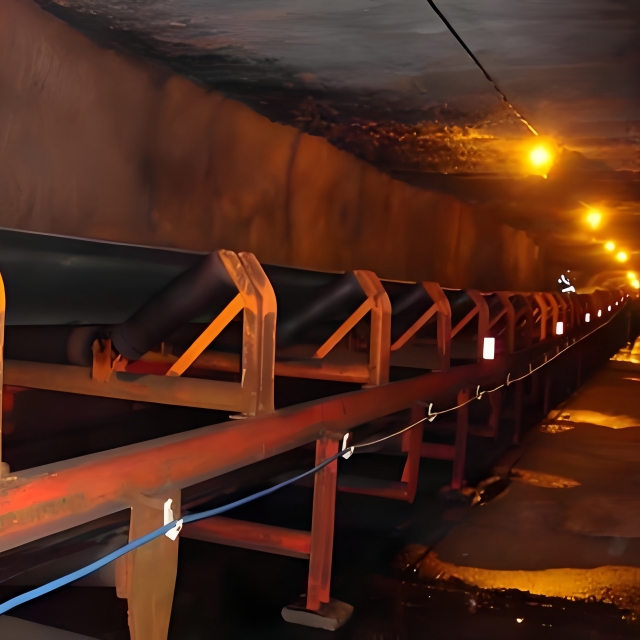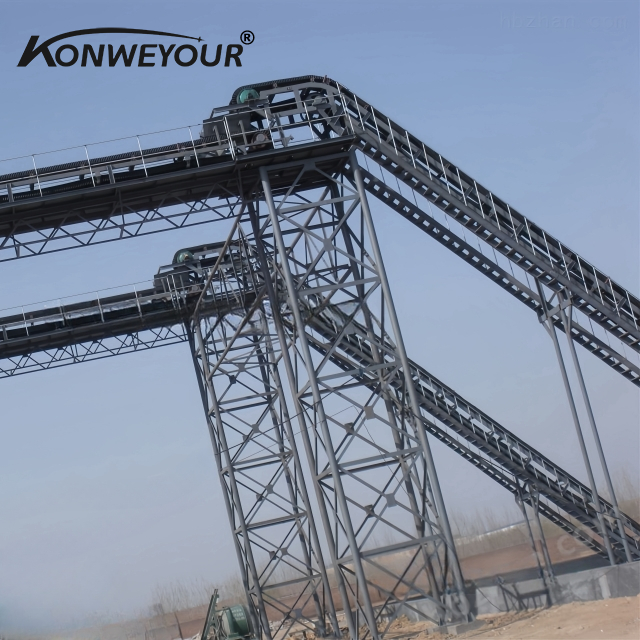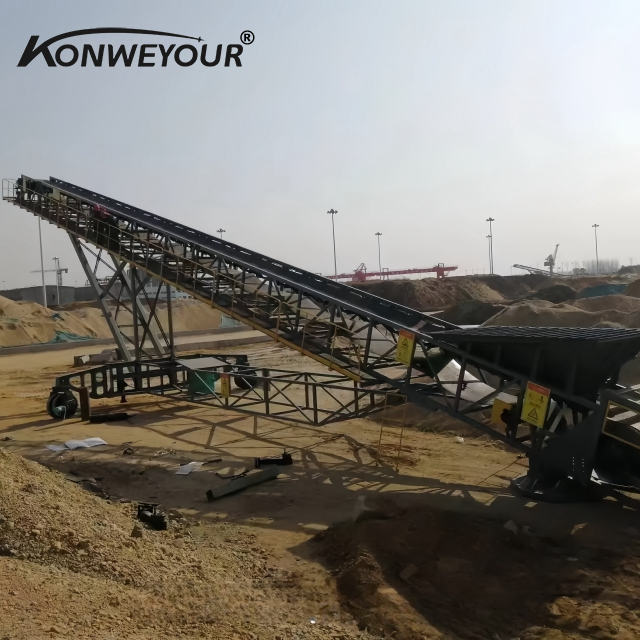Views: 0 Author: Site Editor Publish Time: 2025-10-30 Origin: Site










Mining runs on movement. Every ton of ore, rock, or mineral must go somewhere, and that’s where a mining conveyor system comes in. Instead of relying on fleets of trucks that burn fuel, crowd haul roads, and need constant maintenance, conveyors keep everything flowing smoothly. They move material faster, cheaper, and safer.
But there’s a catch. Not every conveyor fits every mine. Choosing the wrong mining conveyor system can cripple efficiency and drain profits. The right system, however, can boost throughput, cut downtime, and extend the lifespan of every component. Let’s explore how to choose a mining conveyor system that matches your material, terrain, and goals.
A conveyor system is not just a belt turning on rollers. It’s the heartbeat of your material flow. When it stops, so does production.
Every minute of unplanned downtime costs thousands. Trucks sit idle. Crews wait. Machines stall. That’s why conveyor selection should never be an afterthought. Picking the wrong belt or motor can cause tension issues, slippage, or even catastrophic failure.
| Method | Tons per Hour (TPH) | Fuel Cost | Labor Needs | Environmental Impact | Downtime Risk |
|---|---|---|---|---|---|
| Mining Trucks | 300–800 | Very High | 6–8 workers | High emissions | High |
| Overland Conveyor System | 1,000–2,000 | Low | 2–3 workers | Low emissions | Low |
| Underground Conveyor | 600–1,200 | Medium | 3–4 workers | Moderate | Medium |
Mining conveyor systems eliminate many vehicle-related hazards. Fewer trucks on-site means fewer accidents, less dust, and less congestion underground or on surface roads. A properly designed mining conveyor system meets strict safety standards while improving productivity.
Each mining site faces unique challenges. The right mining conveyor system depends on the terrain, the type of material, and the working environment. Let’s look at the most common designs.

Overland conveyors stretch across long distances—sometimes miles—to move material between mines, processing plants, and loading terminals.
Advantages:
Handles high tonnage with low energy costs.
Operates continuously with minimal human intervention.
Reduces truck dependency and fuel consumption.
Design Tips:
Use weather-resistant covers in rainy or windy environments.
Include adjustable tensioners for terrain changes.
Best for: Large open-pit mines, aggregate quarries, and surface operations.

Underground mining requires compact, durable systems that meet underground conveyor belt safety standards.
Key Features:
Flame-resistant and anti-static materials.
Fire suppression and smoke control systems.
Belt widths optimized for confined spaces.
Advantages:
Continuous material flow without manual hauling.
Improved air quality and reduced emissions.
Best for: Coal mines, mineral tunnels, and underground processing zones.

Inclines are everywhere underground. Moving ore upward or downward efficiently is critical.
Why it matters: The incline conveyor angle affects power requirements and belt design.
| Incline Angle | Conveyor Design Considerations |
|---|---|
| 0–10° | Standard flat or troughed belt |
| 10–20° | Cleated belt or increased grip surface |
| 20–30° | Specialized drive power, strong tension control |
Best for: Elevating ore to crushers or lowering waste material safely.

Some operations need flexibility. Portable conveyors are modular and mobile.
Use Cases:
Temporary stockpiling.
Construction sites and sand pits.
Short-term transfers between main conveyors.
Advantages: Easy setup, modular sections, quick relocation.
Choosing the right mining conveyor system requires careful consideration of multiple factors. Each affects performance, safety, and ROI.
Different materials behave differently on a belt.
| Material Type | Considerations |
|---|---|
| Sharp Rock | Needs high abrasion-resistant covers |
| Wet or Sticky Ore | Use sealed or cleated belts |
| Fine Dust | Enclosed or covered system required |
| Hot Slag or Ash | Heat-resistant compounds needed |
Your system’s design must match your production rate. Undersizing the belt causes overloads and slippage; oversizing wastes money.
Low TPH (<500): Light-duty multi-ply belts.
Medium TPH (500–1500): Reinforced fabric or steel cord belts.
High TPH (1500+): Heavy-duty, steel-cord or chain-driven systems.
Long-distance runs need intermediate drives or take-up systems. Steep gradients require cleats and more power.
Tip: For every 100 feet of elevation gain, increase motor power by 10–15%.
Conveyors face heat, moisture, and dust every day.
Underground: Flame-resistant belts per MSHA Part 14.
Desert: UV-resistant materials and cooling systems.
Arctic: Cold-rated rubber compounds and enclosed housings.
You can’t skip this. Underground belts must meet fire safety and anti-static standards. Add guards, pull cords, and shut-off switches to reduce risks.
Good design equals easy maintenance. Add walkways, lighting, and modular sections.
| Component | Maintenance Tip |
|---|---|
| Idlers | Check monthly for misalignment |
| Bearings | Lubricate weekly |
| Pulleys | Inspect lagging for wear |
| Belt | Clean and track daily |
Modern variable frequency drives (VFDs) adjust speed automatically. That saves power and reduces belt wear. It’s an easy win for lowering long-term cost.
A conveyor is an investment. The total cost of ownership includes:
Design and installation
Power consumption
Maintenance labor
Spare parts and downtime losses
Saving 10% on initial setup can cost 40% more in future maintenance. Smart buyers look beyond price.
Safety is non-negotiable in mining. The underground conveyor belt safety standards are clear: systems must resist fire, control smoke, and minimize ignition risk.
Flame-resistant rubber and PVC layers.
Fire barriers between belt sections.
Automated sprinklers and smoke sensors.
Pull cords every 50 feet.
Emergency stop buttons at critical points.
Audible and visual alarms during start-up.
Mining conveyors produce dust. Use:
Skirts and hoods on chutes.
Water misting systems.
Enclosed transfer points.
Pro Tip: A dust-free environment protects both people and equipment, extending belt life.
A conveyor’s performance depends on consistent maintenance. Skipping inspections shortens its lifespan.
Check for belt misalignment.
Look for damage or spillage.
Clear debris from idlers.
Inspect pulleys and drive lagging.
Re-tension belts to prevent slippage.
Replace worn scraper blades.
| Belt Type | Expected Life (Years) | Common Application |
|---|---|---|
| Multi-Ply Fabric | 3–5 | Light to medium loads |
| Steel Cord | 5–10 | Heavy loads and long runs |
| Solid Woven | 5–7 | Underground or damp areas |
Maintenance Tip: Regular cleaning prevents carryback, the biggest cause of premature wear.
| Category | Percentage of Total Cost |
|---|---|
| Initial Equipment | 40% |
| Power Consumption | 20% |
| Maintenance | 25% |
| Downtime Losses | 15% |
Reducing downtime has the highest ROI. Automation and predictive monitoring tools can prevent small issues from becoming major failures.
Problem: Belt slippage
Fix: Re-tension, replace worn lagging, or clean the head pulley.
Problem: Belt misalignment
Fix: Adjust idlers, check frame alignment, inspect loading points.
Problem: Carryback buildup
Fix: Upgrade belt scrapers, add secondary cleaners.
Problem: Excessive dust
Fix: Install transfer chutes, apply water spray systems.
Problem: Overheating motors
Fix: Check load, ventilation, and VFD settings.
How to choose a mining conveyor system that suits my mine?
Consider your material type, throughput, and environment. Each affects belt strength, width, and speed.
Is an underground conveyor safer than trucks?
Absolutely. Fewer moving parts, reduced human contact, and built-in fire-resistant materials mean better safety.
What’s the best conveyor for mining operations?
There’s no single answer. For surface mines, go overland. For confined spaces, go underground with solid woven belts.
How long do belts last?
Typically 3–10 years, depending on type and maintenance.
Do I need an inspection checklist?
Yes. Use daily and weekly logs to track wear and performance.
Now you know how to choose a mining conveyor system—it’s about matching materials, capacity, and environment while never compromising safety. Whether it’s a high-capacity overland system or a flame-resistant underground setup, the right conveyor keeps your operation running at peak performance.
At Konweyour, we design and supply complete mining conveyor systems built for your conditions. From belt selection to installation, we handle it all.
Need a custom conveyor solution?
Contact us today to speak with our mining conveyor experts. Let’s build a system that moves your mine forward.